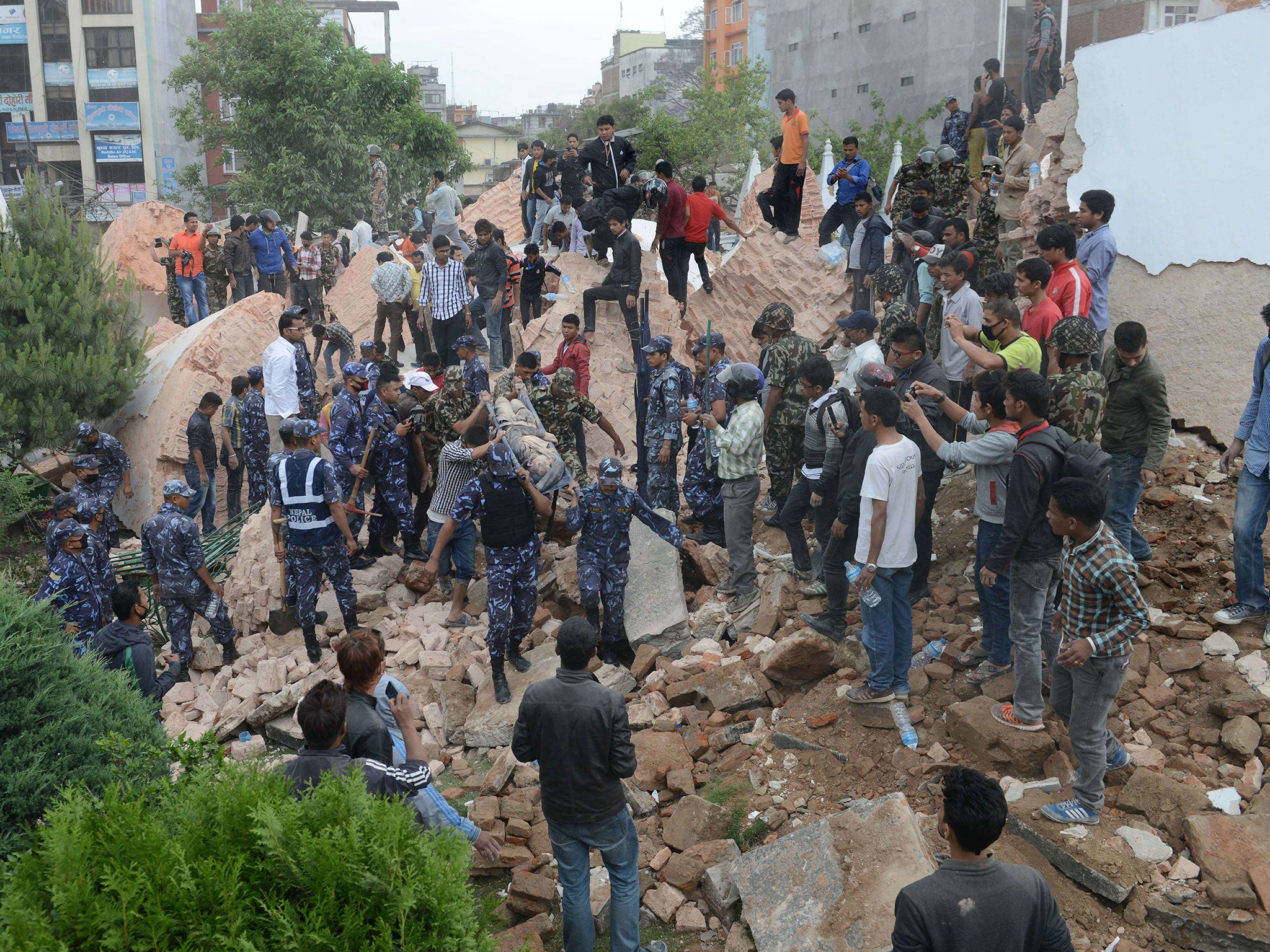Your support helps us to tell the story
From reproductive rights to climate change to Big Tech, The Independent is on the ground when the story is developing. Whether it's investigating the financials of Elon Musk's pro-Trump PAC or producing our latest documentary, 'The A Word', which shines a light on the American women fighting for reproductive rights, we know how important it is to parse out the facts from the messaging.
At such a critical moment in US history, we need reporters on the ground. Your donation allows us to keep sending journalists to speak to both sides of the story.
The Independent is trusted by Americans across the entire political spectrum. And unlike many other quality news outlets, we choose not to lock Americans out of our reporting and analysis with paywalls. We believe quality journalism should be available to everyone, paid for by those who can afford it.
Your support makes all the difference.A massive earthquake in Nepal measuring 7.8 on the Richter scale has killed more than 1,000 people across four countries and triggered a deadly avalanche on Mount Everest.
The death toll has risen to 1,130 in Nepal, police have confirmed.
In the capital Kathmandu 181 people were killed and across the wider Kathmandu Valley, which was badly affected, 467 died.
Another 34 people were killed in India, six in Tibet and two in Bangladesh. Two Chinese citizens died at the Nepal-China border. And at least 18 climbers have been killed in an avalanche on Everest.
The quake, which struck just before noon on Saturday, about 50 miles from Kathmandu in the valley region, is the worst to hit the poverty-stricken Himalayan nation in 81 years.
The government has declared a state of emergency in affected areas. Extensive destruction was reported across the country.
Many of the injured have been rushed to over-stretched hospitals with broken limbs and arms for treatment, often by friends or relatives in rickshaws or other vehicles.
Shirish Vaidya, a local businessman, was at home with his family on the outskirts of Kathmandu, when the quake occurred.
"It is hard to describe. The house was shaking like crazy. We ran out and it seemed like the road was heaving up and down," he said. "I don't remember anything like this before. Even my parents can't remember anything this bad."
A number of buildings collapsed in the central district of the capital, including historic temples, which are hundreds of years old.
A 19th century tower toppled trapping at least 50 people inside. The Dharahara Tower was built in 1832 and had been open to visitors for the past 10 years.
Resident Prachanda Sual said people were running through the streets in panic as ambulance sirens blared and government helicopters monitored the situation from above.
As night fell many people remained outdoors as they were too fearful of aftershocks to return to their homes.
The country is ill-equipped to deal with such an emergency and the disruption to communications has hampered recovery efforts.
Nepal's only international airport, in Kathmandu, was closed following the quake and the prime minister, Sushil Koirala, was unable to return to the country from a summit in Jakarta.
Strong tremors were felt across the wider region and were experienced as far away as India, Bangladesh and China.
Officials in neighbouring Indian states say that at least 34 people have died and dozens more have been injured in Bihar, Uttar Pradesh and West Bengal.
A newsreader in the Indian capital New Delhi, which is more than 500 miles away, said: “Massive tremors have been felt here in Delhi and several other parts of India.”

The quake also triggered an avalanche on Mount Everest, which reports say has killed at least 18 people.
Romanian climber Alex Gavan tweeted there had been a "huge avalanche" and that "many, many" people were on the mountain at the time.
Daniel Mazue said that Everest base camp had been "severely damaged" and his team was trapped.
The quake’s epicentre was almost 49 miles northwest of Kathmandu in the surrounding valley region, which is home to 2.5m people and was the worst affected area.
The US Geological Survey said the earthquake hit at 11.56am local time at a shallow depth of 19 miles. An aftershock measuring 6.6 on the Richter scale struck an hour later and smaller aftershocks continued for hours.
Shallow earthquakes cause more damage, due to their increased intensity and power.
The Indian government has dispatched a military transport plane with three tonnes of supplies and a 40-member disaster team to Nepal. Three further planes are scheduled to be sent later.
Humanitarian agencies are currently assessing the need for assistance in Nepal following the quake. A team of technical experts from Oxfam are preparing to fly in from the UK with supplies to provide clean water, sanitation and emergency food supplies.
Cecilia Keizer, Oxfam country director in Nepal said: "Communication is currently very difficult. Telephone lines are down and the electricity has been cut off making charging mobile phones difficult. The water is also cut off.
"Many of the old houses have been destroyed and at least one large apartment block has come down in Kathmandu. Oxfam is preparing to help provide clean water and emergency food."
Additional reporting by agencies

Join our commenting forum
Join thought-provoking conversations, follow other Independent readers and see their replies
Comments